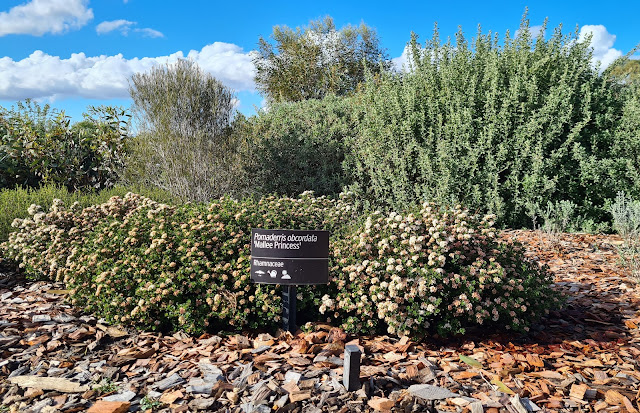An unusual pom that may or may not be Victorian
To a more typical member of the Rhamnaceae family this week, a species of Pomaderris. This is the genus favoured by young Neville Walsh, recently retired from paid employment but now an Honorary Research Associate at Royal Botanic Gardens Victoria.
The species that caught my eye was growing not far from the Siegfriedia featured in last week's post, on Howson Hill at Cranbourne Gardens. It's a cultivar of Pomaderris obcordata called 'Mallee Princess'. Not really your typical 'pom', as the genus name is sometimes shortened.
As poms go, this one is particularly floriferous and rather attractive in bloom. Which is not to say other species aren't. They just tend to flower for a short period and, unless you are Neville, can go largely unnoticed.
While not uncommon in South Australia, the Wedge-leaved Pomaderris is may or may not occur naturally in Victoria. There are only two recorded locations. One, near the border with South Australia, was last seen in 1969. The other, from northern Grampians, has not been recorded since the nineteenth century.
In a rather circuitous sentence in VicFlora, the situation is summed up as follows: 'The absence of recent collections from the original specimen localities, both of which in protected, largely undeveloped but well-collected areas, suggests a possibility of inaccurate locality recording as much as it does extinction of this very distinctive species from Victoria'.
That is, the Wedge-leaved Pomaderris was either never in Victoria, or it was and now isn't.
As that sentence says, the species is distinctive. In the Flora of South Australia, the leaves are described as similar to those of some Spyridium or Trymalium, also in the same family. That leaf form is described botanically as 'obcordate', or heart-shaped with the broader end away from the stalk. Hence the species epithet.
The leaves can also be 'obovate' (oval-shaped with broader end way from the stalk) or 'cuneate' (wedge-shaped), leading to the common name proffered in the Flora of South Australia and used above.
The leaves can also be lobed or divided, up to three times. The top is shiny and hairless but underneath (not illustrated here), softly 'pubesent' with star-shaped hairs, visible if you use a hand lens as Neville would. And in case you are taking a closer look, the veins in the leaves are tracked with simple hairs.
The cultivar 'Mallee Princess' is promoted as a 'delightful, low-growing, evergreen shrub' that produces 'masses of white flowers ... over a long period'. All of which is quite unusual for a Pomaderris, even the 'delightful' adjective.
To return to Pomaderris taxonomy - Neville's wheelhouse - I read that some folks dispute whether this cultivated plant is in fact Pomaderris obcordata. The suggestion is that it may be being confused with Pomaderris paniculosa, which is far more common in Victoria (and also in Western Australia and South Australia).
Neville says not to worry on that score. The two species are nothing like each other, and in different parts of the genus. So assuming everything out there in horticulture looks like these photographs, when you grow 'Mallee Princess', you are growing a selection of Pomaderris obcordata.
A pretty delightful species of Pomaderris which may, or may not, be Victorian.






Comments